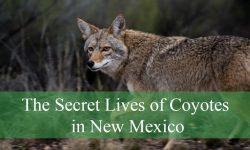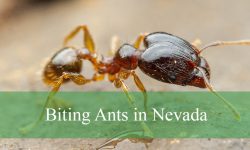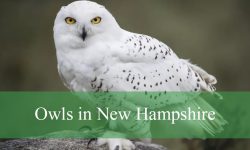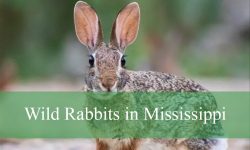Falcons in Arkansas are an exciting group of raptors that birdwatchers can observe throughout the year. These agile birds of prey are known for their speed, sharp vision, and powerful hunting skills. Spotting a falcon in flight—gliding over forests, fields, or wetlands—is always a thrilling experience for nature lovers.
The state is home to five remarkable falcon species, each with distinct behaviors, seasonal appearances, and habitat preferences. The tiny and colorful American Kestrel, the famously fast Peregrine Falcon, and the elusive Prairie Falcon are just a few examples. Falcons in Arkansas can be seen perched on power lines, diving through river valleys, or circling above grasslands in search of prey.
This guide explores the five types of falcons in Arkansas, complete with identification tips, behavior details, and vivid photographs. With the right knowledge and a bit of patience, anyone can learn to recognize and appreciate these fierce and fascinating birds across the diverse landscapes of the Natural State.
Different Types of Falcons Found in Arkansas
American Kestrel (Falco sparverius)
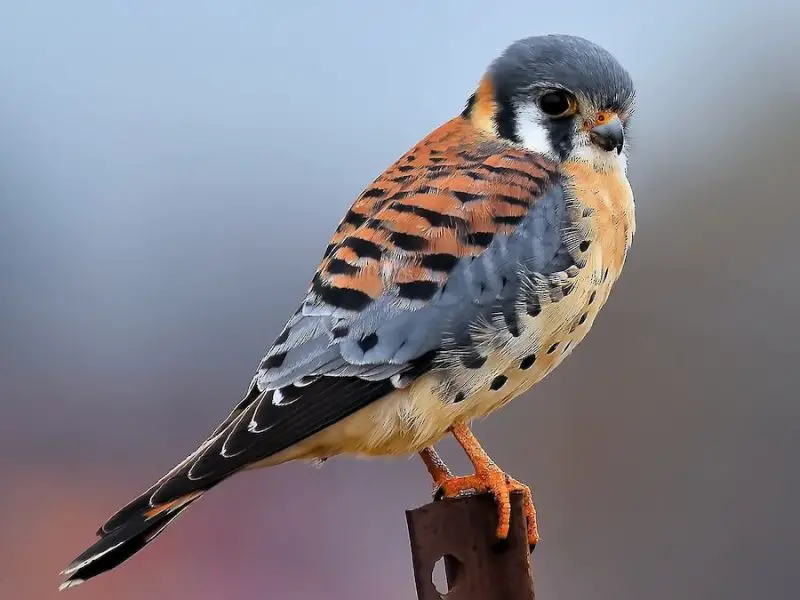
The American Kestrel is the smallest falcon in North America but is widely recognized for its vivid coloration and agility. Adult males are especially striking with a slate-blue head and wings, rusty red back and tail, and two distinct black facial stripes. Females, though more subdued in color, feature a rusty brown back and wings with heavy streaking. This species is sexually dimorphic, meaning males and females look notably different. Kestrels are about the size of a mourning dove and possess a distinct, bobbing flight pattern when hovering in place.
In the field, American Kestrels can be identified by their small stature, rapid wingbeats, and hovering hunting technique. They often perch on utility wires or fence posts along open roadsides and fields. Their call is a sharp, high-pitched “klee-klee-klee,” frequently heard during flight or when defending territory. Their sharp, hooked beak and talons help them quickly dispatch prey such as insects, small rodents, and birds. Males tend to have fewer markings than females and are more colorful overall.
Behaviorally, kestrels are highly adaptable predators. They hunt primarily by sight and can detect the ultraviolet trails left by rodent urine, which guides them to prey. Unlike many raptors, kestrels readily use nest boxes in addition to natural cavities, and they do not build nests themselves. These falcons are monogamous during the breeding season and may return to the same nesting sites each year. During winter, kestrels defend individual hunting territories and become more solitary.
In Arkansas, American Kestrels are common year-round residents, especially in open habitats such as pastures, grasslands, and agricultural areas. They are among the most frequently observed raptors in the state due to their abundance and preference for exposed perching spots. While they can be seen throughout all seasons, their visibility increases in winter as northern populations migrate south, boosting their numbers. They nest throughout the state, taking advantage of the mix of open land and forest edges.
Merlin (Falco columbarius)

The Merlin is a small but powerful falcon, known for its rapid flight and fierce hunting style. Unlike the colorful American Kestrel, Merlins are generally dark and streaky, with males displaying a bluish-gray back and wings and females and juveniles appearing more brownish overall. They have a faint mustache mark and a bold streaked breast, which gives them a rather tough and rugged appearance. This species is compact and fast, with pointed wings and a medium-length tail.
Merlins are best identified by their silhouette and flight pattern. They fly with rapid wingbeats and are less likely to hover than kestrels. Their hunting style is dynamic and aggressive—often chasing small birds in midair at high speeds. They are known for surprising flocks of birds, causing chaos and using that to pick off a target. Their call is a loud, sharp chatter, which is most often heard during the breeding season in more northern regions.
This falcon exhibits intense predatory behavior, preferring to prey on small birds, dragonflies, and occasionally small mammals. They hunt primarily by speed and ambush, and they are known to chase prey over long distances. Merlins do not build nests but instead use abandoned crow or hawk nests in trees. During migration and winter, they are less territorial and more opportunistic, frequenting a variety of habitats that provide hunting opportunities.
In Arkansas, Merlins are considered fairly common winter migrants, especially from late fall through early spring. They are typically seen in open areas near wetlands, large parks, open woodlands, and even urban spaces where bird concentrations are high. Their presence in the state increases during the colder months as they move south from their breeding territories in Canada and the northern U.S. While they don’t breed in Arkansas, they are reliable seasonal visitors.
Peregrine Falcon (Falco peregrinus)

The Peregrine Falcon is one of the most iconic and admired raptors in the world, renowned for its breathtaking speed. As the fastest bird on earth, it can reach speeds over 200 miles per hour during a stoop (hunting dive). Adults have a blue-gray back, barred white underparts, and a distinctive black cap and mustache mark. Juveniles are browner overall with heavy streaking on the chest. Their powerful build and long pointed wings give them an unmistakable silhouette in flight.
Field identification of the Peregrine Falcon includes noting its broad chest, strong wingbeats, and bold facial markings. It is larger than the American Kestrel and Merlin and has a distinctive shape in flight—long, pointed wings with a narrow tail. Their vocalization is a harsh “kack-kack-kack” sound, typically heard near nesting sites or when threatened. Due to their size and hunting prowess, they dominate many smaller raptors in shared environments.
Peregrines are aerial hunters specializing in birds, which they capture in dramatic dives from great heights. Their prey includes pigeons, shorebirds, ducks, and songbirds, depending on the habitat. Historically, they nested on cliffs, but in modern times, especially after population recovery efforts, many have adapted to urban environments, using skyscrapers and bridges as nesting sites. They are monogamous and fiercely territorial during the breeding season.
In Arkansas, Peregrine Falcons are mostly seen during spring and fall migration, although a few individuals have begun nesting in urban locations such as Little Rock. River bluffs, large bridges, and tall buildings provide suitable nesting habitat. The Arkansas River corridor and major flyways are prime spots for observing them during migration. Once endangered, their population has rebounded thanks to conservation programs, making them a welcome seasonal presence across the state.
Crested Caracara (Caracara plancus)

The Crested Caracara is a unique member of the falcon family, distinct in both appearance and behavior. Unlike most falcons, it has a heavy, hawk-like build with a flat crown, bushy crest, and bare facial skin that changes color with mood or activity. Adults display a striking pattern with a dark cap, white neck and tail base, and dark wings with light patches. Its long legs and slow, soaring flight make it appear more like a vulture than a traditional falcon.
This bird is readily identified by its odd combination of falcon and scavenger traits. It often walks on the ground and is frequently seen feeding on carrion, which is unusual among falcons. In flight, its broad wings, slow wingbeats, and flat profile differentiate it from other raptors. Juveniles are browner and more mottled than adults, with duller facial skin and less defined feathering on the chest.
Behaviorally, the Crested Caracara is opportunistic and intelligent. While it is capable of hunting live prey such as reptiles, insects, and small mammals, it often relies on scavenging roadkill or food scraps. It is known to follow vultures or human activity to locate meals and can dominate other scavengers at a carcass. Unlike most falcons, caracaras are more social and can be seen in small groups.
In Arkansas, the Crested Caracara is considered a rare vagrant. It is typically a resident of south Texas, Florida, and parts of Central and South America, but individuals have been spotted occasionally in southern Arkansas, particularly near open pastures or along highways. Most sightings are brief and isolated, often involving young dispersing birds wandering far beyond their normal range. Its rarity in the state makes it an exciting find for local birders.
Prairie Falcon (Falco mexicanus)

The Prairie Falcon is a medium-sized, pale falcon native to arid western North America. It has a sandy-brown back, light underparts, and distinctive dark axillary patches or “armpits” visible during flight. Its face is marked by a single dark mustache stripe and pale eyebrow. Its wings are long and pointed, and it is slightly smaller and lighter in build than the Peregrine Falcon, though similar in overall shape.
Identification in the field involves looking for the pale coloration, especially in flight when the dark underwing patches are clearly visible. Prairie Falcons fly with strong, purposeful wingbeats and often cruise low over the landscape when hunting. Their calls are sharp and high-pitched, usually heard only during the breeding season. They are well adapted to open, dry habitats and use their cryptic coloring for stealth.
This falcon is a powerful and efficient hunter, feeding mainly on small mammals like ground squirrels and birds such as doves and sparrows. It relies on surprise and speed, often flying low to ambush prey. Unlike Peregrines, Prairie Falcons do not stoop from high above but instead engage in horizontal pursuits. They nest on cliff ledges and in steep canyons, using minimal nesting material.
In Arkansas, the Prairie Falcon is a very rare visitor, generally seen only during winter or migration. Most sightings come from the western part of the state in open farmland, grasslands, or dry hills where habitat resembles its typical range. These occurrences are infrequent, and the species does not breed in Arkansas. Nevertheless, each sighting is notable and draws attention from birding communities eager to catch a glimpse of this elusive western falcon.
Best Places to See Falcons in Arkansas
Arkansas offers a wide variety of landscapes—ranging from open grasslands and farmlands to river valleys and urban skylines—that provide excellent opportunities to observe falcons throughout the year. While some species like the American Kestrel are widespread, others require more targeted efforts and the right timing to spot. Below are some of the best places in Arkansas to see falcons, organized by habitat and species likelihood.
Arkansas River Valley
The Arkansas River Valley is one of the top regions in the state to spot falcons, especially during migration seasons. Peregrine Falcons can often be seen along this corridor during spring and fall, using bridges and tall structures to perch or nest. The river’s bluffs and adjacent open spaces also attract American Kestrels and occasionally Merlins during winter. Look near cities like Little Rock and Fort Smith for urban falcon sightings.
Delta Region and Agricultural Fields
The flat, open lands of eastern Arkansas offer ideal hunting grounds for American Kestrels and wintering Merlins. Agricultural areas near Stuttgart, Brinkley, and Marianna are productive spots, particularly when scanning roadside power lines and field edges. During migration, the open sky and abundant prey also make this region a possible route for transient Peregrine Falcons.
Urban Centers and Tall Structures
Cities like Little Rock and Fayetteville have become increasingly important for urban-nesting raptors. Peregrine Falcons have been known to use tall buildings and bridges in downtown Little Rock as nesting sites. Urban green spaces, large city parks, and riverfront areas are all worth scanning, especially during early morning hours when raptors are most active.
Grasslands and Open Prairies
Open areas in western and north-central Arkansas, such as the Cherokee Prairie Natural Area or the Fort Chaffee Wildlife Management Area, provide suitable habitat for American Kestrels and very rare Prairie Falcons during winter. These grasslands mimic the dry, open environments where Prairie Falcons are typically found in the western U.S., making them a good place for rare sightings.
Southwestern Arkansas and Highway Corridors
Crested Caracaras have occasionally been reported in the southwestern part of the state, particularly along highways and in open pastures. While sightings are rare, they often occur near roadkill or carcasses, so keeping an eye out along rural roads—especially in winter—can be rewarding for those hoping to catch a glimpse of this unusual falcon.
For the best results, birders should visit these areas with binoculars during the early morning or late afternoon. Winter and migration seasons tend to offer the highest falcon diversity. Checking local eBird reports or joining birding groups in Arkansas can also provide up-to-date information on recent sightings.

